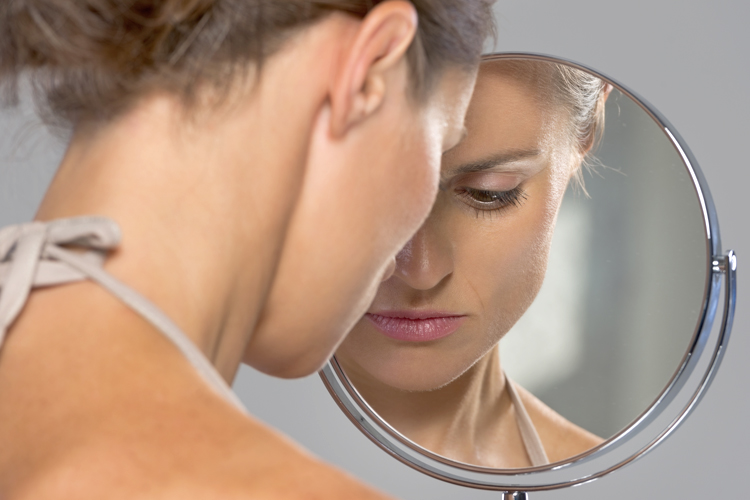My husband likes to squeeze onto what I’ve been taught to call my “muffin top,” the bit of “extra” flesh just above my hips. Recently, he planted a hand on it, squeezed and made a desirous grunting noise that made me think he might eat me alive. “Baby, no!” I protested, batting his hand away. “Don’t squeeze my fat.” His face softened. “But I love it. I love this juicy little oyster,” he said, referencing the tender, most delicious part of a chicken. “It’s the best.”
Funny, I thought it was the worst.
This isn’t just a case of my particular insecurities and my husband’s sexual idiosyncrasies. Studies have shown that straight women overestimate the importance of thinness in heterosexual men’s perception of female beauty. That is to say, women think men prefer ladies much thinner — and “oyster”-less — than they actually do.
It started with a study in 1985, which had men and women use a set of figure drawings to indicate “their current figure, their ideal figure, the figure that they felt would be most attractive to the opposite sex, and the opposite sex figure to which they would be most attracted.” They found that “women thought men would like women thinner than men reported they like.” Similarly, men “thought women would like a heavier stature [in men] than females reported they like.” In other words, both sexes were wrong about what was attractive to the opposite sex — but this misperception only hurt women. That’s because men, unlike women, chose “current, ideal and most attractive” figures that were “almost identical.” The researchers wrote, ”Overall, men’s perceptions serve to keep them satisfied with their figures, whereas women’s perceptions place pressure on them to lose weight.”
Three years later, the same research team found that “mothers and daughters believed that men (of their own generation) prefer much thinner women than these men actually prefer.”
This discrepancy has also attracted the attention of pseudo-scientific surveys. A recent headline in the Daily Mail read, “Men love Kim Kardashian’s curves while women want Emma Watson’s slim hips: Infographic shows the sexes have VERY different ideas about the body beautiful.” The emphasis isn’t always on the figure. Last year, the media went nuts over a study commissioned by a beauty retailer (ehem), which found differences between men’s and women’s perceptions of the ideal female face.
These findings make headlines because they’re surprising: Given the enormous industry around self-improvement, shouldn’t we have an accurate sense of what the opposite sex wants? It also seems to go against what evolutionary psychologists like to call “mate selection theory,” which suggests that women should have an accurate perception of what men find attractive, so as to judge their relative “mate value” (which is such a depressingly dehumanizing term, isn’t it?).
Psychologist David Buss, author of “The Evolution of Desire,” tells me, “Why women are a bit off in what they think men want is a weird modern phenomenon,” he told me. “My speculation is that it is distorted by media images of repeated exposure to ultra-thin female models that have even been photoshopped to make them look thinner than they really are.”
It is possible to explain in evolutionary terms, though. “One ‘input’ into women’s mating psychology is rival women in their ‘social environment,'” he said. “Ancestrally, of course, women would not have been exposed to hundreds of images of these ultra-thin women; small-group living meant that women had perhaps a dozen or two other women of reproductive age that would have effective same-sex mating rivals.” He speculates that “the thinness oddity” began with “the notion that clothes on models ‘hang better’ if the models are thin.” He explains, “Once the models started to get thin, this provided weird, modern, novel input that hijacked women’s sense of who their effective mating rivals were.”
That is to say, “If women perceive their competition to be multitudes of thin models, or their psychology tricks them into thinking that these are their effective rivals, then that could cause this female misperception of what men find attractive.”
There’s another element here, which is the whole “women dress for other women” thing. A 1986 study reported, “For some women, the anticipated reactions of same-sex peers may be of greater importance in their pursuits of slimness than are the anticipated reactions of male peers.” Interestingly, research has shown that women also overestimate the thinness of female peers’ sense of the ideal body. Buss adds that “women compete not just to attract men but also for a position in women’s status hierarchies.” So, it isn’t all about the guys.
Even if straight women could accurately predict what most hetero men find attractive, it would only be true for the average man — and who wants “average,” anyway? For that matter, who wants to live in a world where we are no more than our evolutionarily defined mate value?
There’s evidence to back up Buss’s theory of media brainwashing. Earlier this year, a study found that women’s perception of female beauty varied depending on the images they were exposed to beforehand. Women who were exposed to photos of attractive plus-size models before being surveyed chose a higher BMI as ideal than those who were exposed to attractive “lightweight” models. Men’s perceptions, on the other hand, were not affected by what they were exposed to prior to being surveyed. Simple acts, like publishing plus-size models in advertisements, could actually change women’s bodily ideal — and, as a consequence, move their perception of straight male desire closer to reality. In that case, everybody wins, right?
Well, everyone except advertisers who want to maintain an unrealistic ideal to which women can strive via purchasing an endless array of products.


